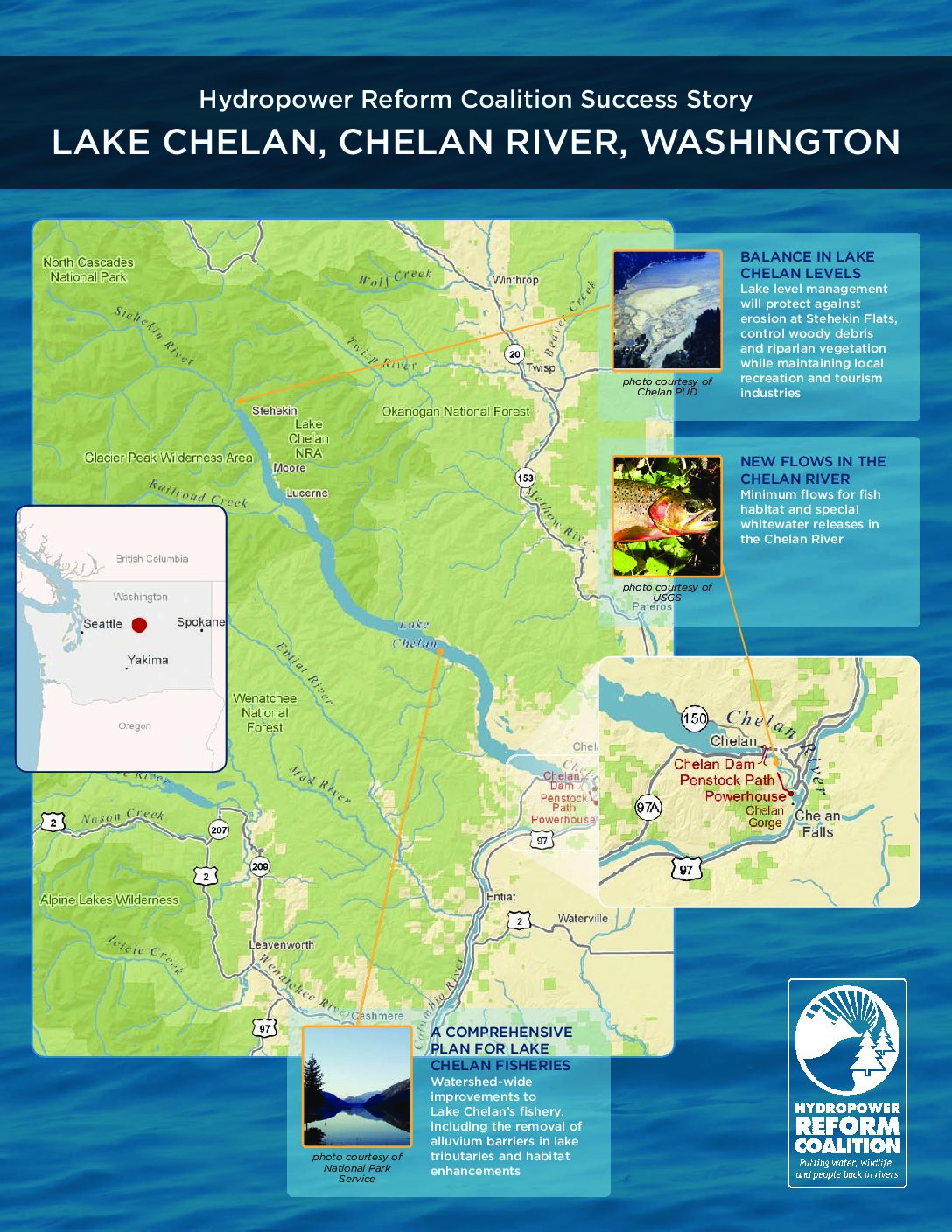Lake Chelan is a freshwater fjord, a lake carved by ancient glaciers. At 1,500 feet deep and 55 miles long, it is the third deepest lake in the United States, and the longest and deepest lake in the state of Washington. The Chelan River, the lake’s outlet, flows four miles into the Columbia River. Over a century ago, the Chelan River’s flows varied by a factor of ten: from 640 cfs in the winter to 6,400 cfs in late spring freshets.
Beginning in 1892, companies began to build dams at the outlet to raise and control Lake Chelan. The first dam, intended for water supply, failed in its first spring season. The next dam was built in 1893 and collapsed in its second spring season. In 1899, a hydropower dam began its construction at the site and successfully provided electricity to the town of Chelan in 1903.
In 1926 and 1927, the Lake Chelan hydroelectric project as we know it today was designed, authorized, and constructed. The 40-foot tall, 490-foot wide Lake Chelan Dam holds back Lake Chelan, with a storage capacity of 15.8 million acre-feet. The dam diverts water through a 2.2 mile tunnel to the powerhouse, dropping 400 vertical feet on its way. After generating power, the powerhouse releases its water into a “tailrace,” a 0.3-mile excavated channel that returns water back into the Chelan River just before it enters the Columbia River.
Under the old hydropower licenses, the Chelan River became an overflow canal from the dam to the tailrace and received no water purposefully. Unless the dam spilled water into the river in high spring flows, when it could not hold back or generate power from all the water, the Chelan River was regularly dry for decades. No permanent fish habitat existed in the river.
The hydropower operating license for the Lake Chelan project expired in 2004. In preparation, project owner Chelan PUD convened negotiations and submitted a settlement agreement in 2003 to the Federal Energy Regulatory Commission (FERC). FERC approved almost all elements of the agreement and issued a new license in 2006 for the maximum duration of 50 years.
Today, Lake Chelan’s lake levels reflect a balance between many objectives. Near the dam, the town of Chelan needs stable, high levels in the summer to foster recreation and successful tourism. Throughout Lake Chelan, healthy fisheries need predictable, quality habitat and the ability to travel between the lake and tributary streams, without sediment barriers or stranding. At the upper end of the lake, levels are designed to stop extreme erosion and seasonally dust- heavy winds from the Stehekin Flats when the lake is drawn down in winter and spring, and to control its effect on encroaching vegetation and wood debris in the lake. The Lake Chelan license created a forum under which resource agencies can cooperate and plan together.
Under the new license, new minimum flows of at least 80 cfs must be released into the Chelan River. Up to 320 cfs may be released, depending on the season and whether the year is a dry, wet, or normal one. These flows were approved by the State of Washington and FERC, and are intended to maximize habitat in the river for westslope cutthroat trout. However, the Confederated Tribes of the Umatilla Indian Reservation refused to sign the final settlement and appealed the minimum flows, arguing that they did not ensure that water quality standards such as temperature and dissolved oxygen – important for fish health – would be met. The state appeal board allowed the flow requirements to stand, acknowledging that while water quality standards would not be met, the result was properly balanced for overall benefit. This fundamental disagreement in the application of water quality standards created a breach within the interested parties that remains unresolved to the satisfaction of all parties.


 HRC or member-contributed
HRC or member-contributed